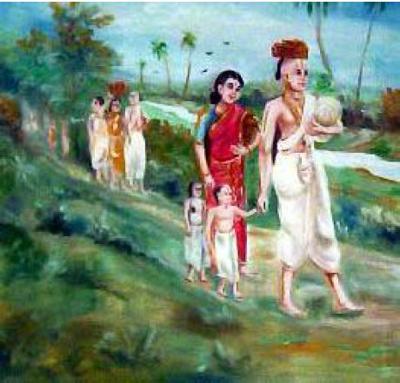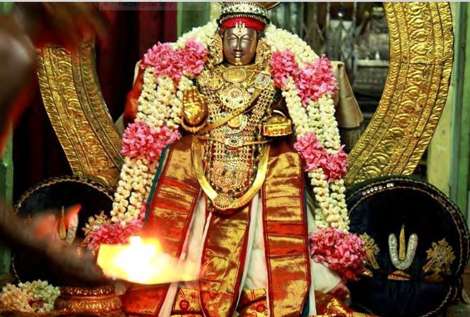Introduction:
As a reference time frame, Swami Desikan’s period on this earth is 1268 to 1369AD. He lived the proverbial 100 plus Veda Praayam. He witnessed many historical events and contributed enormously to the sustenance and growth of Sri Bhagavad RamanujaSiddhantham. One of the most important events in his life crowned with accomplishments as a “VEDANTHAACHARYA” a name given to him by Sri Ranganatha and as “Sarvatantra Swatantrar”, a title bestowed on him by Sri Ranganayaki is connected with Muslim Invasion of Srirangam and the creation of Abheethi Stavam.
Muslim Invasions: The first of the invasions took place in the year 1311, when Swami was 43years old. It was headed by Malik Kafur, who was a general in Allaudin Khilji’s court. He wasa converted Hindu from Gujarat and had fierce ambitions to please his master. He was feared widely. He hit hard, plundered and went back with his loot. The fear created by him lasted. Another invasion by Ulugh Khan followed during 1323 AD, when our Acharya was 55 Years old. He was by that time, one of the most revered Vaishnava Acharyas. He had composed many granthams at the command of Sri Ramanuja, who appeared in his dream. He was deeply absorbed in the Kaimkaryam of the Divya Dampathis and Ubhaya Vedantha Kalakshepam to advance the glorious tenets of Ramanuja.
A disturbing incident happened that had influence on his choice of Satyagalam as a place where he stayed during the invasion by Ulugh Khan. The background is as follows:

The second invasion news spread as Ulug Khan torched his way south towards Srirangam. The residents of Srirangam including Swami Desikan and Sudarsana Bhattar worried about the calamities that could ensue. Sudarsana Bhattar was the author of Srutha Prakasika, the commentary on Sri Bhashyam following strictly the Sri Bhashyam of Ramanuja as preserved by his disciples. Sudarsana Bhattar had two young sons. He was also the chief priest at Srirangam temple. Both the Bhattar and the key people involved with the temple wanted to move the Archa Murthys of Srirangam away and sit out the invasion at a safe distance. They raised a stone wall to hide the Moolavar and transported Sri Ranganatha and Sri Ranganayaki in special boxes and left at the middle of night. With difficult travel, they reached Thirumalai and conducted the daily Aradhanam for the Divine couple there without attracting too much attention. Swami Desikan could not stay behind, once The Divya Dampathis had left Srirangam. He joined Sudarsana Bhattar in Thiruppatthi hills. There Sudarsana Bhattar pleaded with Swami Desikan to protect Srutha Prakasikai and his two sons and stay somewhere deep beyond reach of the Muslim invaders, who might track down those, who removed Sri Ranganatha from Srirangam. Out of his great affection for Sri Bhashyam, Swami agreed and left for the peace and quiet of Satyamangalam, where he was welcomed earlier by the residents with great affection. He gave pravachanams on Srutha Prakasika raised the two sons of the Bhattar as his own. He left from Satyamangalam for Thirunarayanapuram to offer his worship to Sri Ramanuja and Selva Pillai. There he composed Yatiraja Sapthathi; there he also suffered from the separation from Sri Ranganatha and composed Abheethi Stavam in the stavam style of Kuresa, the author of five stavams. He recited many times his stavam on Ranganatha and peace returned to Srirangam as a result of the victory of Chenji king Koppanaaryan. The Chenji king went to Thirupathi and brought Sri Ranganatha back to Srirangam after a brief sojourn at Chenji.
Swami Desikan heard about the good news and returned to Srirangam and regained his mental peace through reunion with 
Source:










Dear moderator,
There is a lot of false information that is present in this page. Yathindra Pravana Prabhaavam which was written close to 500years ago clearly explains what happened during muslim invasion in srirangam. It documents the journey of namperumal with Pillai lOkachariar clearly and categorically. Vedhaanthachariar will not be pleased himself (instead his eyes will be filled with tears of sorrow) when he reads this article – since it is trying to add unfounded glories to him – he is great on his own with his own accomplishments – he personally would not want to take some one else’s name and fame.
Also, please remove the sections which talk about him establishing adhyayana utsavam – there is no records anywhere – please refer to koil olugu or any purvacharya granthas for proper evidence.
adiyen ramanuja dasan
adiyarkku adiyaan